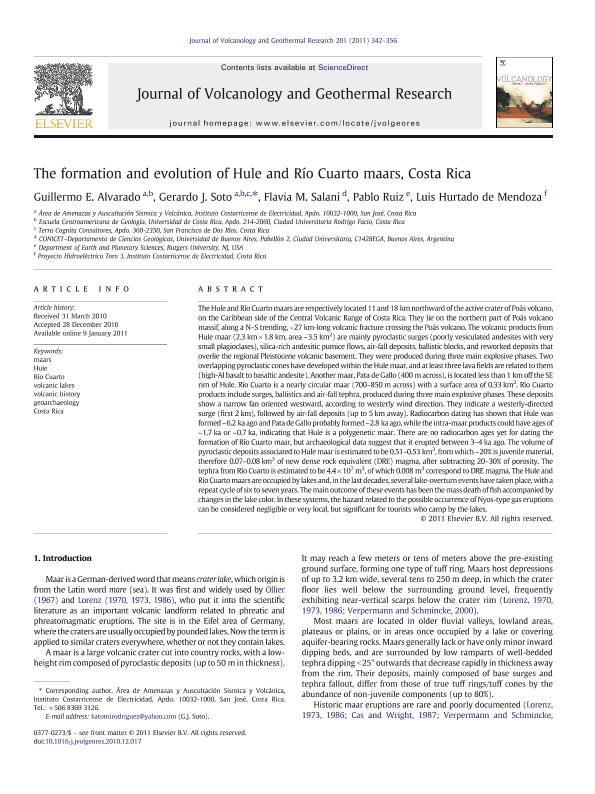Mostrar el registro sencillo del ítem
dc.contributor.author
Alvarado, Guillermo E.
dc.contributor.author
Soto, Gerardo J.
dc.contributor.author
Salani, Flavia Maria

dc.contributor.author
Ruiz, Pablo

dc.contributor.author
Hurtado de Mendoza, Luis
dc.date.available
2019-07-02T19:15:55Z
dc.date.issued
2011-04
dc.identifier.citation
Alvarado, Guillermo E.; Soto, Gerardo J.; Salani, Flavia Maria; Ruiz, Pablo; Hurtado de Mendoza, Luis; The formation and evolution of Hule and Río Cuarto maars, Costa Rica; Elsevier Science; Journal of Volcanology and Geothermal Research; 201; 1-4; 4-2011; 342-356
dc.identifier.issn
0377-0273
dc.identifier.uri
http://hdl.handle.net/11336/79034
dc.description.abstract
The Hule and Río Cuarto maars are respectively located 11 and 18km northward of the active crater of Poás volcano, on the Caribbean side of the Central Volcanic Range of Costa Rica. They lie on the northern part of Poás volcano massif, along a N-S trending, ~27km-long volcanic fracture crossing the Poás volcano. The volcanic products from Hule maar (2.3km×1.8km, area ~3.5km2) are mainly pyroclastic surges (poorly vesiculated andesites with very small plagioclases), silica-rich andesitic pumice flows, air-fall deposits, ballistic blocks, and reworked deposits that overlie the regional Pleistocene volcanic basement. They were produced during three main explosive phases. Two overlapping pyroclastic cones have developed within the Hule maar, and at least three lava fields are related to them (high-Al basalt to basaltic andesite). Another maar, Pata de Gallo (400m across), is located less than 1km off the SE rim of Hule. Río Cuarto is a nearly circular maar (700-850m across) with a surface area of 0.33km2. Río Cuarto products include surges, ballistics and air-fall tephra, produced during three main explosive phases. These deposits show a narrow fan oriented westward, according to westerly wind direction. They indicate a westerly-directed surge (first 2km), followed by air-fall deposits (up to 5km away). Radiocarbon dating has shown that Hule was formed ~6.2ka ago and Pata de Gallo probably formed ~2.8ka ago, while the intra-maar products could have ages of ~1.7ka or ~0.7ka, indicating that Hule is a polygenetic maar. There are no radiocarbon ages yet for dating the formation of Río Cuarto maar, but archaeological data suggest that it erupted between 3-4ka ago. The volume of pyroclastic deposits associated to Hule maar is estimated to be 0.51-0.53km3, from which ~20% is juvenile material, therefore 0.07-0.08km3 of new dense rock equivalent (DRE) magma, after subtracting 20-30% of porosity. The tephra from Río Cuarto is estimated to be 4.4×107m3, of which 0.008m3 correspond to DRE magma. The Hule and Río Cuarto maars are occupied by lakes and, in the last decades, several lake-overturn events have taken place, with a repeat cycle of six to seven years. The main outcome of these events has been the mass death of fish accompanied by changes in the lake color. In these systems, the hazard related to the possible occurrence of Nyos-type gas eruptions can be considered negligible or very local, but significant for tourists who camp by the lakes.
dc.format
application/pdf
dc.language.iso
eng
dc.publisher
Elsevier Science

dc.rights
info:eu-repo/semantics/openAccess
dc.rights.uri
https://creativecommons.org/licenses/by-nc-sa/2.5/ar/
dc.subject
Costa Rica
dc.subject
Geoarchaeology
dc.subject
Hule
dc.subject
Maars
dc.subject
RÍO Cuarto
dc.subject
Volcanic History
dc.subject
Volcanic Lakes
dc.subject.classification
Vulcanología

dc.subject.classification
Ciencias de la Tierra y relacionadas con el Medio Ambiente

dc.subject.classification
CIENCIAS NATURALES Y EXACTAS

dc.title
The formation and evolution of Hule and Río Cuarto maars, Costa Rica
dc.type
info:eu-repo/semantics/article
dc.type
info:ar-repo/semantics/artículo
dc.type
info:eu-repo/semantics/publishedVersion
dc.date.updated
2019-06-03T19:16:39Z
dc.journal.volume
201
dc.journal.number
1-4
dc.journal.pagination
342-356
dc.journal.pais
Países Bajos

dc.journal.ciudad
Amsterdam
dc.description.fil
Fil: Alvarado, Guillermo E.. Universidad de Costa Rica; Costa Rica. Instituto Costarricense de Electricidad; Costa Rica
dc.description.fil
Fil: Soto, Gerardo J.. Universidad de Costa Rica; Costa Rica. Instituto Costarricense de Electricidad; Costa Rica
dc.description.fil
Fil: Salani, Flavia Maria. Consejo Nacional de Investigaciones Científicas y Técnicas. Oficina de Coordinación Administrativa Ciudad Universitaria. Instituto de Geociencias Básicas, Aplicadas y Ambientales de Buenos Aires. Universidad de Buenos Aires. Facultad de Ciencias Exactas y Naturales. Instituto de Geociencias Básicas, Aplicadas y Ambientales de Buenos Aires; Argentina
dc.description.fil
Fil: Ruiz, Pablo. Rutgers University; Estados Unidos
dc.description.fil
Fil: Hurtado de Mendoza, Luis. Instituto Costarricense de Electricidad; Costa Rica
dc.journal.title
Journal of Volcanology and Geothermal Research

dc.relation.alternativeid
info:eu-repo/semantics/altIdentifier/url/https://www.sciencedirect.com/science/article/abs/pii/S0377027311000047
dc.relation.alternativeid
info:eu-repo/semantics/altIdentifier/doi/https://doi.org/10.1016/j.jvolgeores.2010.12.017
Archivos asociados
